Mount Teide National Park
Teide National Park was created in 1954 in recognition of its volcanic and biological singularity. Covering roughly 19,000 hectares (47,000 acres), it is the largest and oldest out of all the national parks in the Canary Islands. It has a peripheral protection area and is surrounded by Corona Forestal Natural Park, which covers an expanse of 46,612.9 hectares (115,183 acres), making this the largest protected nature area in the entire archipelago.
Mount Teide is an active though dormant volcano on the Canary Island of Tenerife. Its highest point reaches 3,718 metres above sea level. It last erupted from the El Chinyero vent on the northwestern rift back in 1909. The mountain is the highest in Spain and 13th highest in Europe. The island of Tenerife is the largest of the Canary Islands and is the third largest volcanic island in the world. The volcano and its surroundings, including the whole of the Las Cañadas caldera, are protected in the Teide National Park which covers an area of 18,900 hecteres. This park was named a World Heritage Site by UNESCO on June 29th 2007. Prior to the 1495 Spanish colonization of Tenerife, the native Guanches referred to the volcano as Echeyde and they believed it held up the sky. The explorer Christopher Columbus reported seeing "... A great fire in the Orotava Valley...," as he sailed past Tenerife on his voyage to discover the New World in 1492.
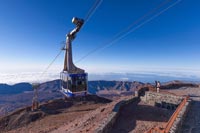 It is believed that Sir Edmund Scory was the first person to ascend the mountain in 1582. Access is by a public road running across the caldera from northeast to southwest. A hotel is located in the National Park along with a small chapel.
It is believed that Sir Edmund Scory was the first person to ascend the mountain in 1582. Access is by a public road running across the caldera from northeast to southwest. A hotel is located in the National Park along with a small chapel.
The Teleférico cable car goes from the roadside at 2,356m most of the way to the summit, reaching 3,555m. Each car carries 38 passengers (34 in high wind) and takes 8 minutes to reach the summit. Access to the summit itself is restricted; a free permit obtainable from the Park office in Santa Cruz is required to climb the last 200m. Due to the altitude, oxygen levels are lower than at sea level making it unsuitable for people who suffer from heart or pulmonary conditions.
Flora and Fauna
The lava flows on the flanks of Teide have weathered to a very thin, but nutrient and mineral rich soil that supports a diverse amount of plant species. Vascular flora consists of 168 plant species, 33 of which are endemic to Tenerife. Forests of Canary Island Pine occur from 1000-2100m, covering the middle slopes of the volcano. At higher altitudes, the Las Canadas caldera provides sufficient shelter for more fragile species such as the Canary Island cedar.
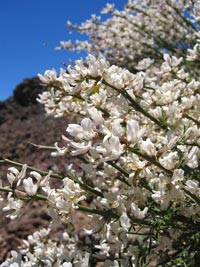 The most dominant plant species in the Teide National Park are the Teide white broom, which has a white and pink flower and the Canary Island wallflower, which has white and violet flowers.
The most dominant plant species in the Teide National Park are the Teide white broom, which has a white and pink flower and the Canary Island wallflower, which has white and violet flowers.
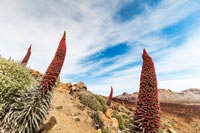 Echium wildpretii is a dominant herbaceous biennial plant, whose red flowers form a pyramid up to 3m in height. The species is endemic to the island of Tenerife, growing in the subalpine zone of the ravines of Mount Teide. It requires a lot of sun and is found in arid and dry conditions, but it tolerates frost down to -15 °C. The common names for this plant are tower of jewels or red bugloss. The Spanish word for this plant is tajinaste.
Echium wildpretii is a dominant herbaceous biennial plant, whose red flowers form a pyramid up to 3m in height. The species is endemic to the island of Tenerife, growing in the subalpine zone of the ravines of Mount Teide. It requires a lot of sun and is found in arid and dry conditions, but it tolerates frost down to -15 °C. The common names for this plant are tower of jewels or red bugloss. The Spanish word for this plant is tajinaste.
The Teide Daisy can be found at altitudes close to 3,600m above sea level while the Teide Violet can be found right up to the summit of the volcano, making it the highest flowering plant in Spain. These plants are adapted to the tough environmental conditions on the volcano such as high altitude, intense sunlight, extreme temperature variations, and lack of moisture. Adaptations include acquiring semi-spherical forms, acquiring a downy or waxy cover, reducing the exposed leaf area, and having a high flower production.
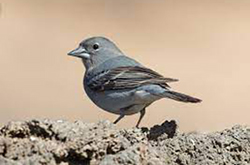 |
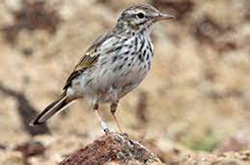 |
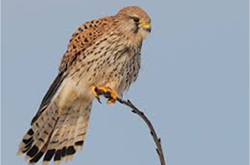 |
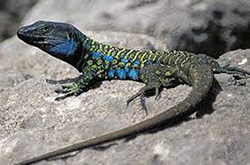 |
| Blue chaffinch | Berthelot’s pipit | Falco tinnunculus canariensis | Gallotia galloti |
The Teide National Park contains a huge range of invertebrate fauna, over 40% of which are endemic species, with 70 species only being found in the National Park. In contrast there is a limited variety of vertebrate fauna. Ten species of bird nest in the park. These include the blue chaffinch, Berthelot’s pipit, the wild canary, and a species of kestrel (Falco tinnunculus canariensis). Three endemic reptile species are also found in the park – the Canary Island Lizard, the Canary Island wall gecko, and the Canary Island skink.
Gallotia galloti (Tenerife Lizard or Western Canaries Lizard) is a wall lizard. It is found on the Canary Islands of Tenerife and La Palma. The striking colour of adult males and their curious nature endear them to many tourists. At popular sights, notably Mount Teide, the lizards have become rather tame and an attraction of sorts themselves. It is quite popular to bring some ripe bananas along for the lizards, which are a most favourite food of this species and will provide travellers with good photo opportunities as the animals scurry over the rocks and even onto visitor's hands to catch a bite.
The only mammals native to the park are bats, the most common species of which is Leisler’s bat. Other animals such as the mouflon, rabbit, house mouse, black rat, feral cat, and the Algerian Hedgehog have all been introduced to the park.
 Español (España)
Español (España) English (United Kingdom)
English (United Kingdom)